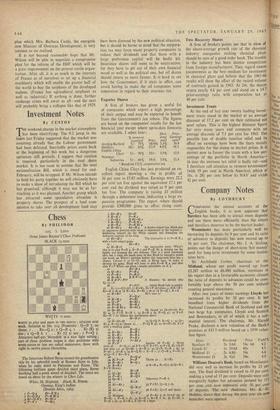Chess
By PIIILIDOR
215. S. Lovo (from James Rayner's-Chess Problems) BLACK (4 men'
WI-ITTE 16 men;
WHITE to play and mate in two moves ; solution next week. Solution to No. 214 (Promislo) : Q-B 7, no threat. r . . . Kt-Q 2 ; 2 Q-B 4. 1 . . . Kt (Kt 3) else ; 2 Q-B 8. t . . . Kt (Q 3) any ; 2 P-Q 5. Attractive half-pin 'Meredith' in a nice light setting ; part of chess problem jargon is that problems with seven pieces or less are called miniatures, those with eight to twelve pieces Merediths.
The American Robert Byrne earned the grandmaster title by his splendid result at Buenos Aires in July, when he came third to Petrosian and Kcres. The following brilliant game decided third place, Byrne finishing half a point ahead of Najdorf. The notes are based on those by the winner in Chess Life.
White, M. NAJDORP. Black, R. BYRNE. Opening, King's Indian. (Buenos Aires, 1964)
r P-Q 4 Kt-K 11 3 2 P-Q 134 P-K Kt 3
3 Kt-Q B 3 11-Kt A P-K a P-0 I
5 Kt-B 3 0-0 6 B-K 2 P-K 4
7 P-Q 5 Q Kt-Q z 8 B-Kt 5 P-K R 3 9 11-1? 4 P-K Kt 4 ro B-Kt 3 Kt-R 4 A double-edged line. Black gets
an aggressive position with room to manwuvre at the expense o weakening himself on the White squares and damaging the defensive position of his king.
rr Kt-Q 2 . . . The alternative is it P-K R 4 with n knife-edged game.
II . . . Kt-B 5 12 11-B r? . . . An instructive error. White's idea is to play P-B 3, B-B 2 and P-K Kt 3, driving out the knight and keeping the two bishops. This is a good positional idea, but it loses too much time, to that Black by energetic attack can break up White's position before this long-term plan has a chance. Correct is 12 0-0, and, no Byrne says, 'in order to develop his game, Black will have to play P-K B 4. and then after P x P White can plant a knight powerfully on K 4.' 12.__. . Kt-13 4 13 Q-8 2 P-B 4
14 P-B 3 P-B 31 15 11-13 2 K B Px P
16 K B P x PPP . . A blunder; he should play Kt (21x P T6 . . . P x P?? . . . which Black fails to exploit 16 . .. Kt (4)-Q 6 chi; 17 B X Kt, Kt xP ch! wins e.g. IS K-B I Kt-K 6 ch or t8 K-K2, B-Kt 5 ch or 18 K-Q r, R x B 17 13 x Kt! . . . He's seen it!
P-Q 5!
:8 B-R 3 P x Kt 19 Q x P B-Kt 5 zo P-R 3 B-R 4
21 P-K Kt 4 B-Kt 3 22 Q-Kt 4 . . . lie feared 22 0-0-0, P- Kt 4; 23 PxP, K-B t; 24 13-13 4 ch, P-Q 4!; 25 P x P. Kt-K 7 th! Hence this preliminary move.
22 . . R-B 21 23 0-0-0 . • • 23 Ept_xQ P. 1,27.1.2; 24 Q- Kt 4, R-Q 61 (threat 25 . • • P-Q R 4); 25 -0, B x P with a winning game.
23 R-Q 2
24 K-Kt r R-13 1
25 K-R r K-R 2 26 Q-Kt 3 P-113
27 Q-K 3 P-Kt 4!
28 Px P . . . Against 28 P-Kt 3 Byrne gives 28 ... P-Q 4l; 29 13 P xQ P, It x Pl; 30 P x R, Kt XIQ P! and wins e.g. 3t Q-Kt 7, R-I3 2; 31 QxP, P-K5 ch; 33 B-Kr z, Q-R t; 34 R-Q Kt a R-B 7: 35 Q-R 3, I° -Kt s: 36 Q-R 7 Kt-B 2.
28 . . . P-Q 4!
.79 Kt PxP PxP Threat 3o . . . R x Kt. 30 n-Kt .5 R-Q 4 31 B-K 2 . . . 31 B-R 4. R-Q 6; 32 Q-K a R x B (Byrne).
31 • • • Kt 11
32 Q x Kt R-x 537 33 P-11 7 R-Q 6
34 Q-K r . . .
34 • • • R x B 35 hr-Kt; - . . . 35 . . . Q-K 21
36 Kt-R 5 . • • 36 P x R?. QxP and mates. 36 - • • Q-K 3? 37 Resigns . . . 37 P-Kt 3, R (7)xP ch; 38 K-K.t t, P-K 6 ch; 39 K-B a, R-R 8 ch; 40 K-Kt 2, P--K s ch: 41 K-B 2. R (6)-R 7 mate.
Otherwise P-K 6.
35 P X R?. Q-Q 5 ch.


































 Previous page
Previous page